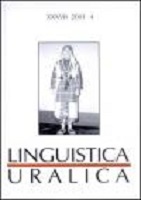The Morphology of Mari Negation
The Morphology of Mari Negation
Author(s): Péter SimoncsicsSubject(s): Finno-Ugrian studies
Published by: Eesti Teaduste Akadeemia Kirjastus
Keywords: Mari language; Finnish; negation; morphology
Summary/Abstract: Mari — like most of the cognate Finno-Ugric/Uralic languages — is using negative auxiliary as means of negation. Yet on the surface it differs very much from its close cognate, Finnish. The reason for this difference can be found in the shift of the stress from the first syllable to the last one containing a full vowel, which took place under the ifluence of the neighbouring Turkic languages (Tatar, Bashkir and Chuvash). The shift of the stress triggered vowel-rotation by which the two conjugational type can be brought to a common denominator. By the same reason, in historical pespective a common origin can also be found for the two past tense markers (-j and -š) of Mari.
Journal: Linguistica Uralica
- Issue Year: LII/2016
- Issue No: 1
- Page Range: 32-43
- Page Count: 12
- Language: English

